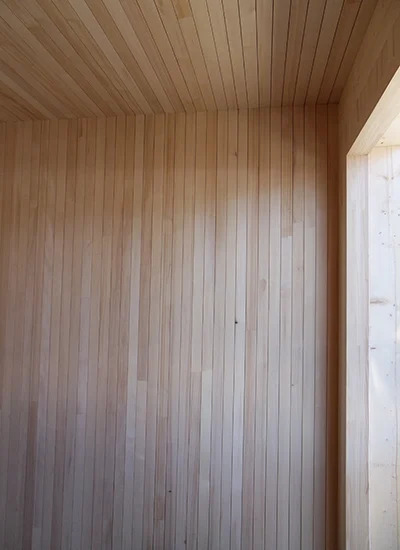& Construction

Integrated BIM tools, including Revit, AutoCAD, and Civil 3D
& Manufacturing

Professional CAD/CAM tools built on Inventor and AutoCAD
From sidewalks to countertops, concrete is everywhere, and it has been around in some form since ancient times. The earliest recorded use of a concrete-like substance dates back to 6500 BC, when a group of traders in the Middle East figured out how to use sand, limestone, water, and cement to build water-management systems in the desert. It worked back then, and it still works today. Suffice it to say, concrete has serious staying power, and although the process to make it has evolved, its basic ingredients and binding materials are the same.
Concrete has drawbacks—it’s difficult to transport, and production comes at an environmental cost—but the material’s durability is hard to beat. Concrete has inspired remarkably innovative alternatives, now used in the built environment, that are strong, aesthetically pleasing, lightweight, and carbon-neutral. These include self-healing organic bricks made from fungus, a concrete-like building material created with hemp, and chic-looking mass timber beams that can sequester a significant amount of carbon dioxide. Plus, thanks to new technology, concrete can now be 3D-printed, resulting in a much smaller footprint.
Green concrete is a blanket term for a type of concrete that has at least one component derived from waste materials. It doesn’t require as much energy to produce as traditional concrete, so it emits far less carbon dioxide. Green concrete can be just as durable as the old-school stuff but with a much more sustainable lifecycle. Like traditional concrete, it can be used effectively for constructing pavements, rooftops, walls, flooring, and bridges. It also provides insulation, improved air quality, and enhanced biodiversity.
Another popular alternative to traditional concrete is ashcrete, a material composed of fly ash, which is a by-product of combustion coal that was once discarded in landfills. But fly ash has found a place in construction: When mixed with lime and water, it turns into a surprisingly strong and durable material that’s a lot like regular cement, reducing the demand for virgin materials. The presence of fly ash enhances ashcrete’s flowability, making it easier to handle than traditional concrete, with improved workability for building complex forms. And because 25% of cement can be replaced with high-volume fly ash, the use of ashcrete leads to a significant reduction in carbon-dioxide emissions.
Hempcrete is a concrete alternative that gets five stars for its eco-friendliness. As the name suggests, it’s made from hemp, a plant that takes approximately four months to grow and can be harvested in perpetuity. Hemp plants don’t demand much water, and they don’t require chemicals or fuel to grow. They’re also surprisingly easy to harvest.
Hempcrete is made by mixing lime and water with hemp fibers to produce a material that’s similar to traditional concrete but much lighter. Lime releases roughly 80% less carbon than traditional concrete, and hempcrete also has the unique ability to sequester carbon throughout its lifecycle. This makes it yet another carbon-negative material. It’s nontoxic, allergen-free, and has the ability to absorb and release moisture, which helps prevent the buildup of mold. Although hempcrete cannot be used in load-bearing walls because it takes so long to cure, it can provide natural insulation and bring flexibility to most structures.
Mass timber tops the list of stylish concrete alternatives for its contemporary aesthetic. It’s made from composite wood systems that combine multiple pieces of wood into larger structural elements to create a material that’s often stronger than concrete or steel. Mass timber is most commonly engineered into structural panels, posts, and beams, but its ability to withstand heavy traffic also makes it a sustainable option for large floors. It’s lightweight and durable, so it’s much easier to transport than traditional concrete. Plus, mass-timber construction also functions as a form of carbon removal due to its ability to sequester an estimated 1 metric ton of carbon dioxide per cubic meter of mass timber.
CLT, or cross-laminated timber, is a type of mass timber. It’s an engineered-wood-panel product comprising at least three layers of kiln-dried dimension lumber, and when it's properly installed and maintained, it doesn’t rot or mold. Like other mass-timber products, it’s also fire resistant and chars when it’s burned. This char forms a protective layer on the outside of the material, retaining its strength. CLT is commonly used for prefabricated structural applications such as walls, floors, and roofing.
Cast polymer is a blanket term referring to the production of synthetic cast products for a range of uses. Cast polymers used for construction include products that can easily be transported and maneuvered without dangerous and expensive overhead equipment. They can also be specifically designed to meet the strength requirements of a given application—a great choice for projects that are highly customized. Their resistance to bacteria and mold growth makes them ideal for construction projects in commercial kitchens and bathrooms, as well.
Until recently, builders didn’t have proper intel on the construction history of older buildings, which made repurposing used building materials to create new structures risky. Advancements in technology have changed this. Programs such as Autodesk Tandem can now be used to connect data from a building’s lifecycle within a digital replica while material passports can provide data on the materials used in a project. The more that’s known about what went into a building, the safer it is to reuse or repurpose old materials. Salvage materials that are still in good shape don’t ever need to go to waste. This is an environmentally friendly and cost-effective construction approach that can also add aesthetic appeal and charm to the final structure.
It turns out that mushrooms have value far beyond their nutritional benefits. The rootlike fibers of mushrooms, known as mycelium, can be dried and processed, then turned into wallets, clothes, and even building materials when coaxed to grow into a rock-solid substance. Mycelium is remarkably heavy-duty; bricks made from it are lighter and more fire-resistant than traditional concrete. And because they’re technically still “alive” after they’re made, mycelium bricks are also self-healing. A damaged mycelium brick can easily repair itself when some extra fungus is packed into its cracks.
As a long-term building material, mycelium bricks are still in development, but the idea that the built environment may one day include structures made from biodegradable fungus is exciting. Back in 2014, an exhibition at New York’s Museum of Modern Art showcased an architectural installation called Hy-Fi, made entirely from mycelium and agricultural waste. Hy-Fi is no longer standing, but engineers are experimenting with the potential of mycelium for future, more permanent structures.
Concrete alternatives provide benefits that extend far beyond the environmental advantages. Having access to so many new sustainable building material options gives architects and engineers a lot more design flexibility. Concrete alternatives also offer faster construction times, reduced labor costs, enhanced durability, and even noise reduction. Today, more and more companies are taking advantage of the benefits offered by concrete alternatives. Embracing these innovations helps companies meet evolving market demands while contributing to a greener, more sustainable future.
Advantic is an Ohio-based start-up that develops customized composite materials to give engineers and builders new options for combating conditions like harsh weather and corrosion. The company’s first major project, completed in 2014, was helping the New York City subway system meet new fire-code ventilation requirements. The building material also needed to be noncorrosive and permeable to radio frequencies. This goal was accomplished using cast-polymer composites, which are 75% lighter than concrete while maintaining the same compressive strength.
“We’re kind of the ‘easy button,’ if such a thing exists, in the construction industry,” says Advantic President Brad Doudican. “If composites are the right solution, we’re going to find the right material solution that addresses the specific problem.”
Advantic’s materials were put to the test again when the company was approached by the Cleveland Metropark Zoo about modifying its existing gorilla enclosure. The zoo was getting ready to introduce a new gorilla into the environment and wanted to give all the animals more space, so Advantic designed a gorilla chute. The chute is an elevated tunnel that offers gorillas a 360-degree view of their habitat. It’s made from composite beams instead of steel to lessen disruption to the gorillas and other neighboring animals.
“With steel fabrication, you have toxic gases with welding, loud and intrusive installation, and generally a more caustic environment,” says Advantic CAD Engineering Technician Luke Sideras. “We were able to cut and drill all our beams in our warehouse before they even got to the zoo. This drastically reduces the downtime that the gorillas are required to be moved, which can cause stress to the animals. It was a really fun project to work on and worked out extremely well for everyone.”
New materials can be risky for owners and contractors, but Advantic and comparable companies use tools such as Autodesk Fusion to track project changes in real time. This process helps optimize project delivery and builds customer trust in concrete alternatives. Successes like these are helping Advantic and other sustainable building manufacturers make inroads in construction.
Greener concrete alternatives may be a big part of sustainable construction’s future, but traditional concrete isn’t going completely out of fashion. Luckily for concrete’s many advocates, new building methods can make its use much more sustainable. Thanks to new technology, it won’t be long before 3D-printed concrete is a mainstream process.
The field of 3D-printed concrete is still evolving, but it’s quickly becoming a reality. By offering more design freedom, faster construction times, and enhanced sustainability, it has the potential to revolutionize construction practices. It’s already beginning to open up new design possibilities, enabling the fabrication of pieces architects want without prohibitive overhead costs. 3D-printed concrete will also save a significant amount of time and materials, leading to a much smaller footprint.
Concrete has changed the world, and there’s a reason why people still use it to build things—because it works. But architecture, engineering, and construction (AEC) professionals are increasingly aware of the impact that concrete and other human activities have on the planet. There’s still a long way to go, but the shift to sustainable building practices has already contributed to a significant reduction in global emissions. It’s also inspiring some exciting new design possibilities.
“Governments around the world will institute draconian policies and slap enormous penalties on those who contribute to climate change,” says Charles Kibert, director of the Powell Center for Construction and Environment at the University of Florida and author of Sustainable Construction: Green Building Design and Delivery. “In comparison, companies that have learned to operate with low impacts and make low-impact products and buildings will thrive in this future.”
Construction today leverages innovative solutions to create more sustainable structures, greener building materials, and more efficient processes. The global population is a lot bigger than it was in 6500 BC, but new alternatives to traditional concrete give the AEC industry an opportunity to accommodate more humans in a responsible way. These solutions are revolutionizing the way buildings, cities, and communities are built, helping present and future generations tread lightly while making a big impact.
This article has been updated. It originally published April 2018.
Elizabeth Rosselle is a freelance journalist, copywriter, and designer who splits her time between San Francisco and Bali, Indonesia.
AECO
AECO
Emerging Tech








